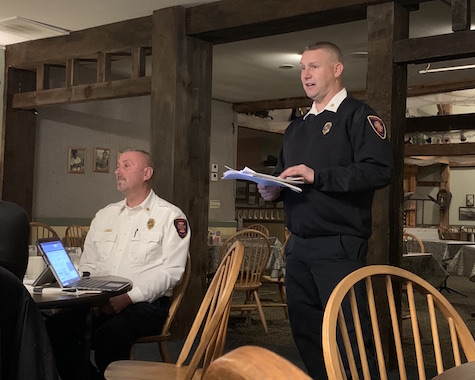Officials says EMS system in crisis locally
Central, eastern Orleans in particular often face long responses

Photos by Tom Rivers: Justin Niederhofer, deputy director of Emergency Management Office in Orleans County, speaks at Tuesday’s Orleans County Association of Municipalities meeting at Tillman’s Village Inn. Dale Banker, the EMO director at left, also shared challenges facing EMS providers.
ALBION – The EMS system is in crisis in Orleans County, with too few responders and not enough ambulances, often resulting in delayed responses.
That was the message from the county’s Emergency Management Office which reviewed recent data showing increased dropped calls and slower responses, especially in eastern and central Orleans.
The western end of the county, which is primarily served by the Medina Fire Department with career firefighters, isn’t plagued by the issues.
Justin Niederhofer, deputy director of Emergency Management Office in Orleans County, said many of the paramedic and EMT positions require extensive training, but don’t pay very well with little fringe benefits. The pay isn’t much better than working in fast food or minimum wage jobs, without the training and responsibilities.
The shortage of responders has long been a concern among local officials, but in recent months the response times have grown longer with more dropped calls in central and eastern Orleans, Niederhofer said.
The ambulance providers are fiscally challenged with low reimbursement rates from Medicare and Medicaid, and many patients who keep the insurance checks rather than turning them to the ambulance companies, Niederhofer said. There are also many patients without insurance resulting in little revenue for COVA, Monroe Ambulance and other providers.
The county is looking to establish a task force to strengthen the local EMS, and one solution may include creating some positions through the county to help improve response times and service to residents in a health crisis. Some other counties have added ambulances and staff to supplement services and fill gaps in EMS coverage.
“There are 12 broken pieces to the puzzle,” said Dale Banker, the county’s emergency management director.
He wants to see the state change a law to allow the ambulance providers to directly be paid by insurance companies, rather than the checks going to patients who often keep them.
The companies also need higher reimbursement rates to better cover their costs and pay their staff more.
Banker and Niederhofer said they will continue to look at models in other counties in the state, to see how they are trying to improve EMS services.
“Every county around us is being impacted,” Niederhofer said.

Allen Turner, communications director at the dispatch center for the county, said many people call for an ambulance when they don’t need one, which stresses the EMS system.
In Orleans County, only the Kendall Fire Department continues to run an all-volunteer ambulance. Albion, Clarendon, Holley and Carlton all have taken their ambulances out of service.
That puts more pressure on COVA in central Orleans and Monroe Ambulance for eastern Orleans to respond to calls.
The fewer ambulances in the county also are tend to be more unavailable with the closing of Lakeside Memorial Hospital in Brockport. Those ambulances have to drive farther towards Rochester to hospitals. Although the Brockport site is now Strong West, the ambulances still are often sent to Rochester hospitals and that ties up crews for longer times. Niederhofer said the short-staffed hospitals also are slower in being able to accept patients. What used to be one or two hour call is often four hours or more, Niederhofer said.
That longer time commitment also is leading to increased burnout, especially for the volunteers, he said.
County legislators Ken DeRoller and John DeFillipps said the EMS challenges need to be a top priority for the elected officials at the village, town, county and state levels.
“This is a major deal,” DeRoller said during Tuesday’s meeting. “We need leadership in this county.”
DeFillipps urged the county officials to “step up” and take the lead. The county showed with broadband internet it can lead in resolving an issue of county-wide importance, he said.
Many of the town, village and county officials said they would serve on the task force and would push for solutions with the EMS crisis.
“Let’s get a task force together and get it done,” said Richard Moy, the Clarendon town supervisor.
In the meantime, Allen Turner, the county’s communications coordinator for dispatch, said a public information campaign is needed to educate people on appropriate calls for an ambulance. Many people could be transported in a personal vehicle which wouldn’t tie up an ambulance, Turner said.
“We have a lot of people who call unnecessarily,” he said.
The public also has an unrealistic expectation that the ambulance will be there within five minutes of a call, Turner said.
DeRoller said quick action is needed because he fears some of the ambulance providers are struggling and may not be able to keep providing service, “which will put even more pressure on the system.”





































































